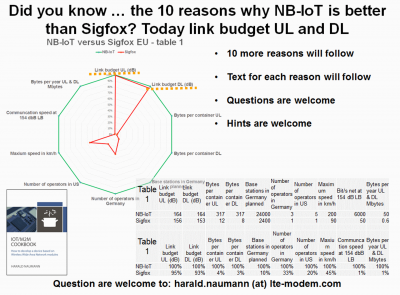The link budget (LB) describes the delta of the transmitted and received power at the receiver. If the Maximum Coupling Loss (MCL) is exceeded, reception is no longer possible.
For NB-IoT this is 164 dB. At 164 dB LB, the number of frame repetitions is already high. 164 dB can only be achieved in stand-alone mode. However, Inband or Guarded Band operation is common. With 154 dB LB ten years of battery life are achievable with 5000 MWh. NB-IoT networks are therefore constructed with 154 dB LB or even better. With Sigfox EU, the link budget is unbalanced in upload (UL) and download (DL). At 163 dB, UL is five dB better than DL 158 dB link budget. With some Sigfox modules, the link budget in the DL is even less than 158 dB. This is due to the lower sensitivity of the modules. The unbalanced link budget means that no download or acknowledgement operation is possible at the edge of a radio cell. With all LPWAN technologies, the link budget affects the range and penetration of a building’s walls. The claimed 50 km range is not achieved in practice. The attenuation caused by buildings in a city quickly reduces the possible range by 50 %. If one assumes antenna locations at 25 m height, then the maximum range is reached at 1.5 to 2 km. If you are a keen sailor you can demonstrate this when you install a 25 m high antenna mast in the middle of the sea and then the same arrangement in a terrain with buildings when you get back to the shore. The ranges in low mountain regions or valleys are even shorter because the mountains limit the radio waves. A radio wave at 800-900 MHz extends little further than the line of sight. Since the earth is not a disk, but an unshapely potato with many irregularities, hundreds of kilometers are only possible if the receiver is very high up, for example in a balloon in the sky. However, real life transmision does not take place in balloons, but in the inner rooms of buildings. The relationship between the range of LPWAN and the link budget, the height of the antenna system, the curvature of the earth, the topography and the buildings will be described in another short article.
Summary link budget with NB-IoT and Sigfox
The link budget of NB-IoT and Sigfox is similar. Therefore, the practical range of the two LPWAN techniques is also similar. For extreme ranges and downloads, NB-IoT is better than Sigfox due to its symmetry. Sigfox cannot guarantee symmetrical upload and download for several reasons. The asymmetry with UL and DL is only one of the reasons for a lack of download possibilities with Sigfox’s radio protocol.
References:
- NB-IoT: a sustainable technology for connecting billions of devices https://www.ericsson.com/en/ericsson-technology-review/archive/2016/nb-iot-a-sustainable-technology-for-connecting-billions-of-devices
- Link budget: https://en.wikipedia.org/wiki/Link_budget
- Radio Link Budget: details & formula https://www.electronics-notes.com/articles/antennas-propagation/propagation-overview/radio-link-budget-formula-calculator.php
- Radio Basics by Christophe Fourtet at Sigfox / #5 The budget link https://www.youtube.com/watch?v=jrXCKTgxIBk
- Coverage Comparison of GPRS, NB-IoT, LoRa, and SigFox in a 7800 km² Area https://www.researchgate.net/publication/321116619_Coverage_Comparison_of_GPRS_NB-IoT_LoRa_and_SigFox_in_a_7800_km_Area
Does this article gain your interest? Do you have a wireless IoT idea? Do you plan an IoT device with embedded antennas? Do you have an IoT prototype and have a need for optimisation or price? If your answer to any of these qustions is “YES”. Then do not hesitate to drop an email to harald.naumann (at) lte-modem.com and to ask for an akorIoT radio adapter or some engineering services to make your IoT idea reality.

1 Comment
Add a Comment